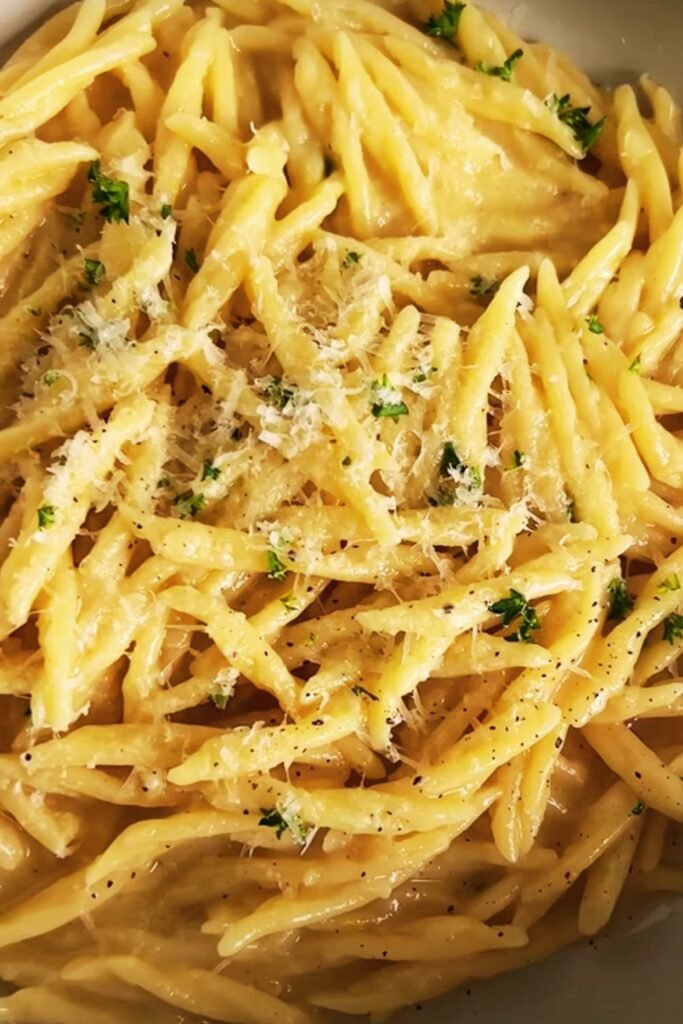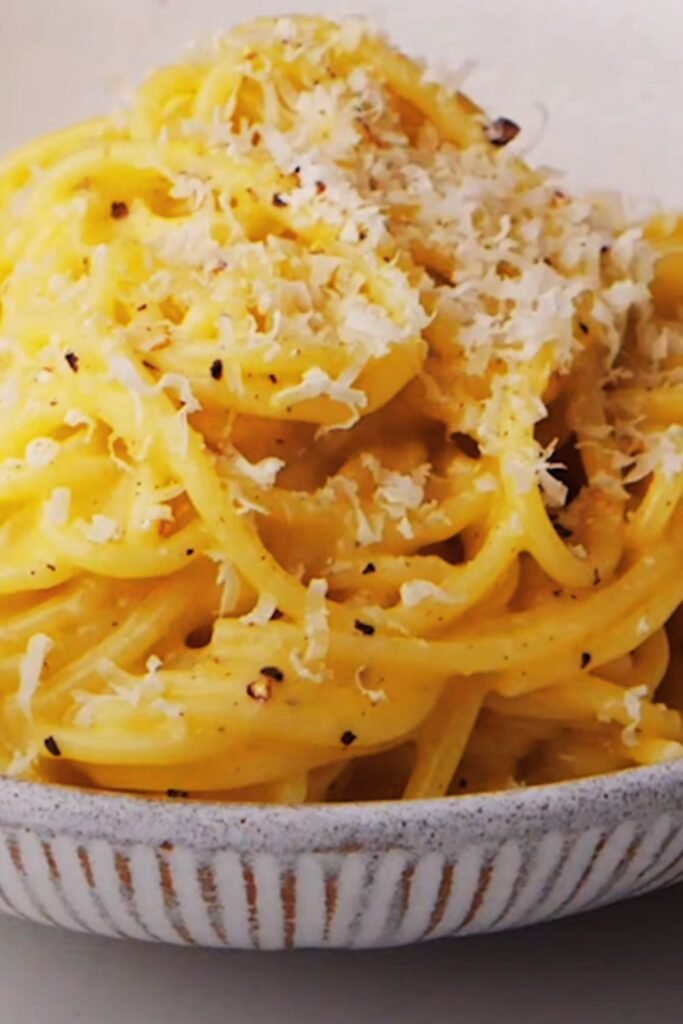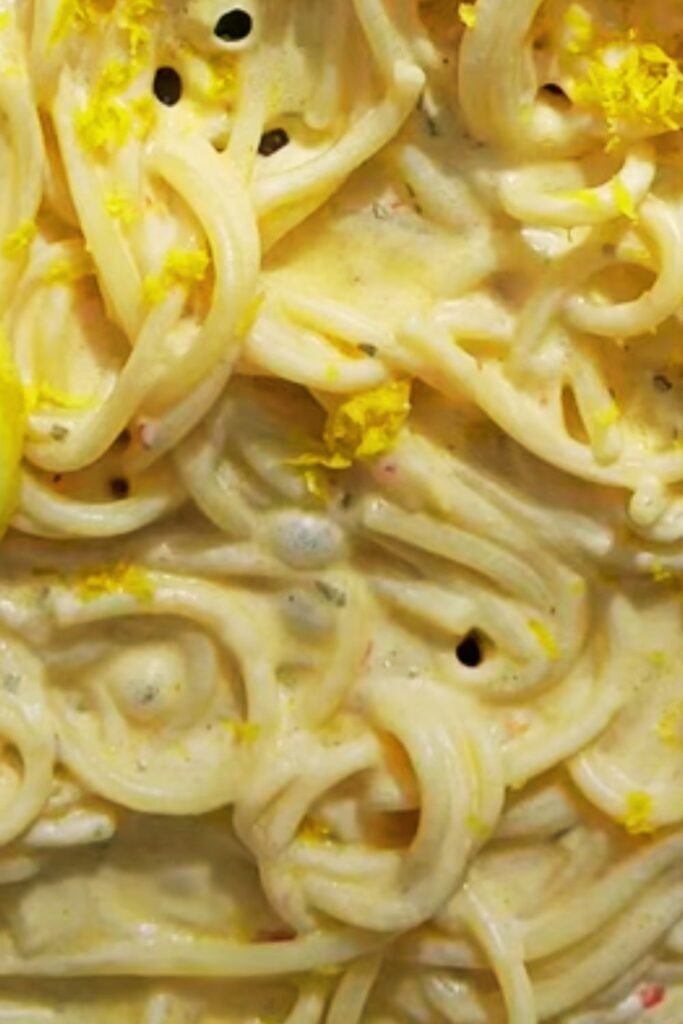There’s something absolutely magical about the combination of creamy sauce, bright lemon, and aromatic garlic dancing together in a bowl of perfectly cooked pasta. I’ve been making this Easy Creamy Lemon Garlic Pasta for years, and it never fails to impress both my family and dinner guests. What started as a weeknight emergency meal has become one of my most requested recipes.
This dish represents everything I love about Italian-inspired cooking – simple ingredients that create extraordinary flavors. The beauty lies in its simplicity: fresh garlic sautéed until fragrant, cream that transforms into silk, and lemon that brightens every single bite. I’ve perfected this recipe through countless iterations, and I’m excited to share my secrets with you.
Why This Recipe Works Every Time
I’ve discovered that the key to exceptional creamy lemon garlic pasta lies in understanding the science behind each component. The cream doesn’t just add richness – it creates an emulsion that coats each strand of pasta perfectly. The garlic, when properly sautéed, releases compounds that form the aromatic foundation of the dish. Meanwhile, the lemon zest provides essential oils that elevate the entire flavor profile.
My approach focuses on timing and temperature control. I’ve learned that adding ingredients in the right sequence prevents the cream from breaking and ensures the garlic never burns. This recipe has saved me countless times when unexpected guests arrive or when I need something comforting after a long day.
Essential Ingredients Breakdown
Understanding each ingredient’s role helps you create restaurant-quality results at home. Here’s what makes this dish extraordinary:
Fresh Garlic: I always use fresh garlic cloves rather than pre-minced versions. Fresh garlic provides a cleaner, more vibrant flavor that doesn’t compete with the delicate cream sauce.
Heavy Cream: The fat content in heavy cream (36-40%) creates the perfect consistency for coating pasta. I’ve tested this recipe with lighter alternatives, but nothing compares to the luxurious mouthfeel of heavy cream.
Fresh Lemon: Both zest and juice play crucial roles. The zest contains essential oils that provide intense lemon flavor without acidity, while the juice adds brightness and helps balance the richness of the cream.
Quality Pasta: I prefer using linguine, fettuccine, or penne for this recipe. The sauce clings beautifully to these shapes, ensuring every bite delivers the perfect flavor balance.
Parmesan Cheese: Freshly grated Parmigiano-Reggiano adds saltiness and umami depth that complements the lemon’s acidity perfectly.

Complete Recipe Details
Ingredients List
| Ingredient | Amount | Notes |
|---|---|---|
| Pasta (linguine or fettuccine) | 12 oz | Cook until al dente |
| Heavy cream | 1 cup | Room temperature works best |
| Fresh garlic cloves | 4-5 large | Minced finely |
| Fresh lemon | 1 large | Zested and juiced |
| Butter | 3 tablespoons | Unsalted preferred |
| Parmesan cheese | 3/4 cup | Freshly grated |
| Fresh parsley | 1/4 cup | Chopped finely |
| Salt | To taste | Sea salt or kosher salt |
| Black pepper | 1/2 teaspoon | Freshly ground |
| Red pepper flakes | 1/4 teaspoon | Optional, for heat |
Nutritional Information Table
| Nutrient | Per Serving | % Daily Value |
|---|---|---|
| Calories | 485 | 24% |
| Total Fat | 28g | 36% |
| Saturated Fat | 17g | 85% |
| Cholesterol | 89mg | 30% |
| Sodium | 387mg | 17% |
| Total Carbs | 45g | 16% |
| Dietary Fiber | 2g | 7% |
| Protein | 16g | 32% |
| Vitamin C | 12mg | 13% |
| Calcium | 245mg | 19% |
Step-by-Step Cooking Instructions
Preparation Phase
I always start by gathering all my ingredients and preparing them completely before I begin cooking. This French technique called “mise en place” ensures smooth execution and prevents any rushed moments that could compromise the dish.
First, I bring a large pot of salted water to boil. The water should taste like the sea – this is where your pasta absorbs its foundational seasoning. While waiting for the water to boil, I zest my lemon using a microplane grater, being careful to avoid the bitter white pith. Then I juice the lemon and set both zest and juice aside in separate small bowls.
Next, I mince my garlic cloves very finely. I’ve learned that uniform mincing prevents some pieces from burning while others remain raw. I also grate my Parmesan cheese fresh – the pre-grated versions contain anti-caking agents that prevent smooth melting.
Cooking the Pasta
When my water reaches a rolling boil, I add the pasta and cook it according to package directions minus one minute. This ensures the pasta finishes cooking in the sauce, absorbing flavors and achieving the perfect texture. I always reserve one cup of the starchy pasta cooking water before draining – this liquid gold helps create the silky sauce consistency.

Creating the Sauce
While the pasta cooks, I heat a large skillet over medium heat and add the butter. Once it melts and stops foaming, I add the minced garlic. This is a critical moment – I stir constantly and cook until the garlic becomes fragrant but not brown, usually about 30-45 seconds.
I then pour in the heavy cream, whisking gently to combine with the garlic butter. I let this mixture simmer for about 2-3 minutes, stirring occasionally. The cream should thicken slightly but not boil vigorously, as this could cause it to break.
Bringing It All Together
When the pasta is ready, I add it directly to the skillet with the cream sauce using tongs. This is where the magic happens – I toss the pasta with the sauce, adding pasta water gradually until the sauce coats every strand perfectly.
I remove the skillet from heat and add the lemon zest, lemon juice, and half the Parmesan cheese. I toss everything together, then add the remaining cheese and fresh parsley. The residual heat melts the cheese and creates a glossy, restaurant-quality finish.
Timing and Temperature Guide
| Cooking Stage | Time | Temperature | Key Points |
|---|---|---|---|
| Pasta boiling | 8-10 minutes | Rolling boil | Cook 1 minute under package time |
| Garlic sautéing | 30-45 seconds | Medium heat | Watch for fragrance, not browning |
| Cream simmering | 2-3 minutes | Medium-low | Gentle bubbles, not vigorous boil |
| Final assembly | 2-3 minutes | Off heat | Residual heat melts cheese |
| Total cooking time | 15-18 minutes | Various | From start to serving |
Pro Tips for Perfect Results
Through years of making this dish, I’ve developed several techniques that guarantee success every time. Temperature control ranks as the most crucial factor – too high heat will break the cream sauce and burn the garlic.
I’ve found that adding the lemon juice off the heat prevents the cream from curdling. The acidity in lemon can cause dairy to separate if added when too hot. Similarly, I add the Parmesan cheese gradually and off heat to ensure smooth melting.
One technique I swear by involves creating a “mantecatura” – the Italian method of vigorously tossing pasta with sauce and pasta water. This creates an emulsion that makes the sauce cling perfectly to each strand.

Variation Ideas and Customizations
My basic recipe serves as a foundation for countless variations. I often add grilled chicken or shrimp for protein, incorporating them during the final assembly phase. For vegetarian options, I might include roasted asparagus, cherry tomatoes, or sautéed mushrooms.
When I want a lighter version, I substitute half the cream with reserved pasta water and add an extra egg yolk for richness. This creates a carbonara-style consistency that’s equally satisfying.
For those who enjoy heat, I increase the red pepper flakes or add a pinch of cayenne pepper with the garlic. The spice complements the lemon beautifully and adds complexity to the flavor profile.
Storage and Reheating Guidelines
Leftover creamy lemon garlic pasta requires special attention when storing and reheating. I store it in the refrigerator for up to three days in an airtight container. The sauce will thicken considerably when cold, which is completely normal.
For reheating, I never use the microwave as it tends to make the sauce grainy. Instead, I place the pasta in a skillet over low heat with a splash of cream or pasta water. I stir gently until warmed through, adding liquid as needed to restore the original consistency.
Troubleshooting Common Issues
Even experienced cooks sometimes encounter challenges with cream-based pasta sauces. Here are solutions to the most common problems I’ve encountered:
Broken or Curdled Sauce: This usually happens when the heat is too high or lemon juice is added to hot cream. I fix this by removing from heat immediately and whisking in cold cream, one tablespoon at a time.
Greasy Sauce: This occurs when the fat separates from the cream. I remedy this by adding pasta water gradually while tossing vigorously to re-emulsify the sauce.
Bland Flavor: Under-seasoning is common with cream sauces. I taste and adjust with salt, pepper, and additional lemon juice. Sometimes the dish needs more Parmesan cheese for depth.
Too Thick or Too Thin: Pasta water is my secret weapon for consistency adjustment. I add it gradually for thinning or let the sauce simmer briefly for thickening.
Serving Suggestions and Pairings
I love serving this pasta as a main course for dinner parties because it feels elegant yet approachable. I typically pair it with a simple arugula salad dressed with lemon vinaigrette to echo the pasta’s citrus notes.
For bread, I prefer garlic breadsticks or crusty Italian bread that guests can use to capture every drop of sauce. I sometimes prepare roasted vegetables like broccoli or Brussels sprouts as a side dish, as their slight bitterness balances the rich cream sauce.
When entertaining, I often serve this pasta family-style in a large, warmed serving bowl. I garnish with extra lemon zest, fresh parsley, and a generous shower of Parmesan cheese.
Make-Ahead Strategies
While this pasta is best served immediately, I’ve developed strategies for busy weeknights. I can prepare the garlic oil base earlier in the day, storing it at room temperature. I also pre-grate the Parmesan cheese and zest the lemon.
For meal prep purposes, I sometimes make the sauce separately and store it in the refrigerator. When ready to serve, I cook fresh pasta and combine it with the reheated sauce, adding pasta water to achieve the proper consistency.
Seasonal Adaptations
During spring, I incorporate fresh peas or asparagus spears for color and texture. Summer variations might include cherry tomatoes or fresh basil leaves. In autumn, I sometimes add butternut squash cubes or sage leaves for earthier flavors.
Winter versions can include sautéed spinach or sun-dried tomatoes for additional richness. These seasonal additions keep the recipe fresh and exciting throughout the year.
Questions and Answers
Q: Can I use half-and-half instead of heavy cream? While heavy cream creates the richest, most stable sauce, you can substitute half-and-half. However, I recommend adding a tablespoon of flour mixed with butter (beurre manié) to prevent breaking, and keep the heat very low throughout cooking.
Q: What’s the best pasta shape for this recipe? I prefer long pasta shapes like linguine, fettuccine, or angel hair because they hold the sauce beautifully. However, short shapes like penne or rigatoni work well too, as their tubes and ridges capture the creamy sauce effectively.
Q: Can I make this recipe dairy-free? I’ve successfully adapted this recipe using cashew cream and nutritional yeast. Soak 1 cup raw cashews overnight, blend with 1 cup water until smooth, and use this as your cream base. Replace Parmesan with nutritional yeast for umami depth.
Q: How do I prevent the garlic from burning? The key is medium to medium-low heat and constant stirring. I watch for the garlic to become fragrant and just barely golden. If it starts browning too quickly, I lower the heat immediately or remove the pan from heat temporarily.
Q: Can I add protein to this dish? Absolutely! Grilled chicken, shrimp, or scallops work beautifully. I cook the protein separately and add it during the final tossing stage. For chicken, I season with salt, pepper, and Italian herbs. For seafood, I keep seasoning simple with just salt and pepper.
Q: Why does my sauce sometimes look greasy? This typically happens when the emulsion breaks due to high heat or insufficient starch. I fix this by adding pasta cooking water gradually while vigorously tossing the pasta. The starch helps re-bind the sauce components.
Q: How can I make this recipe lighter? I create a lighter version by using half cream and half reserved pasta water, plus one egg yolk for richness. I also increase the lemon juice slightly to maintain flavor balance. Another option is using Greek yogurt mixed with a small amount of cream.
Q: What should I do if my sauce is too salty? If over-salted, I add more cream or pasta water to dilute the saltiness. Sometimes adding a touch more lemon juice helps balance the flavors. In extreme cases, I might add more cooked pasta to absorb excess salt.
Q: Can I freeze leftover pasta? Cream-based sauces don’t freeze well as they tend to separate when thawed. I recommend consuming leftovers within 2-3 days from the refrigerator. If you must freeze, expect texture changes and plan to add fresh cream when reheating.
Q: How do I know when the sauce consistency is perfect? The sauce should coat the back of a spoon and cling to the pasta without being gluey. When you lift pasta with tongs, the sauce should flow smoothly but not be watery. It should look glossy and cohesive, not separated or grainy.
This Easy Creamy Lemon Garlic Pasta has become my go-to recipe for countless occasions, from weeknight dinners to special celebrations. The combination of simple techniques and quality ingredients creates a dish that feels both comforting and sophisticated. I encourage you to make this recipe your own by experimenting with the variations I’ve suggested, but always remember that the foundation – perfectly cooked pasta, properly emulsified sauce, and balanced flavors – remains constant. Each time you prepare this dish, you’ll discover new nuances and develop your own preferred techniques. That’s the beauty of cooking – it’s both an art and a science that rewards practice and experimentation.